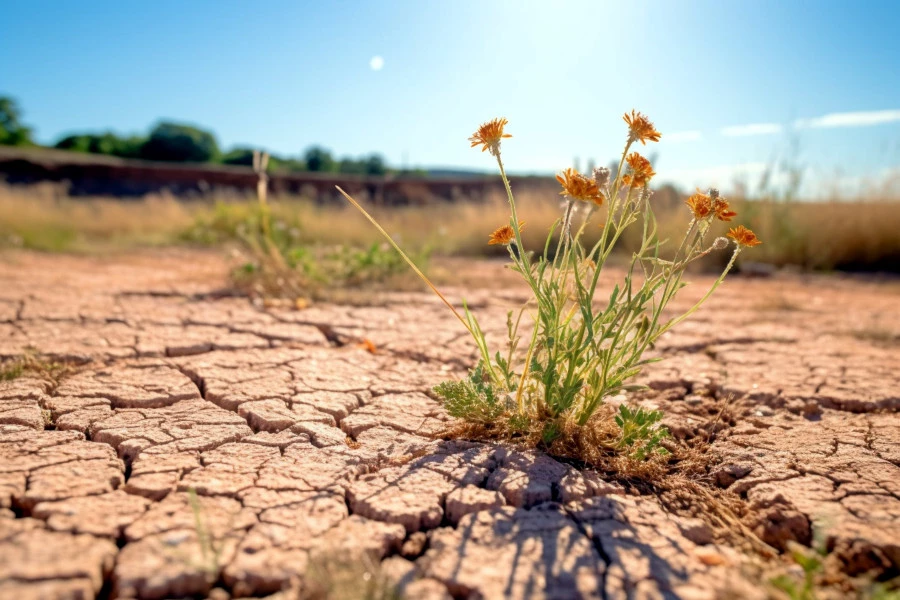Healthy, glowing skin isn’t just about vanity; it’s about self-care, confidence, and living your best life. Dry skin, one of the most common skin types, has unique characteristics and requires specific care to maintain its health and beauty.
Whether you’ve always had dry skin or you’re experiencing changes due to aging, climate, or lifestyle, this ultimate guide is for you.
Not sure what type of skin you have? You should read: How to Find Your Skin Type and Get Glowing, Radiant Skin!
Here’s what we’ll be looking at in this guide:
Understanding Dry Skin
Dry skin is very common and with a little focused care, you can definitely learn to manage it well. So let’s have a look at some of the main causes and characteristics to get started.

Want to understand your dry skin better? Here’s a quick look at what we’re going to talk about next:
- What is Dry Skin?
- The Main Characteristics
- What Causes Dry Skin?
- Aging and its Influence on Dry Skin
- The Difference Between Dry Skin and Other Skin Types?
What is Dry Skin?
Dry skin, or xerosis cutis, is a common skin condition characterized by lack of appropriate water levels in the most superficial layer of the skin, the epidermis.
Dry skin tends to feel rough and may have fine lines or cracks, which may sometimes become deep, painful fissures. In severe cases, it can exhibit scaling and itching, leading to an uncomfortable feeling.
The Main Characteristics
Dry skin exhibits some well known characteristics, including a feeling of skin tightness, especially after showering, bathing, or swimming. In addition, it often appears dull, particularly on the cheeks and around the eyes.
Dry skin may also lack elasticity, making fine lines and wrinkles more noticeable. Additionally, there may be visible peeling or flaking, redness, and rough texture. Itching, cracking, and bleeding are also common in severe cases.
What Causes Dry Skin?
There are various causes of dry skin, and these range from environmental factors to underlying medical conditions. Weather changes, particularly during winter when humidity levels are low, can cause skin to become dry.
Dry skin can also come about because of over-washing, especially with harsh soaps. It can also be caused by certain medical conditions.
Aging and its Influence on Dry Skin
As we journey through life, our skin inevitably goes along for the ride, and one of its most common companions is dryness. It’s an often-overlooked fact, but as we age, our skin’s capacity to hold onto moisture diminishes, and its natural oil-producing abilities can also decrease. This is largely due to the reduced production of natural hydrating agents like hyaluronic acid and collagen.
What does this mean for our skin? Simply put, mature skin becomes more prone to dryness and dehydration. The changes might seem subtle at first—a little tightness here, a touch of roughness there—but over time, these can escalate to more noticeable signs of dry skin, including pronounced lines and wrinkles, itching, flaking, and even a compromised skin barrier leading to increased sensitivity.
If you’re in your mature years, it’s essential to adapt your skincare routine accordingly. Ingredients like hyaluronic acid, glycerin, ceramides, and peptides become your skin’s best allies, as they can help restore moisture, fortify the skin’s natural barrier, and promote a smoother, plumper appearance.
At the same time, avoid harsh cleansers that strip away natural oils and instead opt for gentle, moisturizing formulas. Regular exfoliation can also help by removing buildup of dead skin cells, allowing hydrating products to penetrate more effectively.
Remember, the most vibrant skin at any age is well-hydrated skin. So, as you embrace the wisdom of your years, make sure your skincare routine matures beautifully with you.
The Difference Between Dry Skin and Other Skin Types
Dry skin differs from the other skin types primarily in oil production and moisture levels. Unlike oily skin, which produces an excess of sebum, dry skin doesn’t produce enough, leading to a lack of natural oils on the skin’s surface.
Normal skin is well-balanced, meaning it produces just enough oil to keep the skin’s barrier function optimal and its moisture level appropriate. In contrast, dry skin struggles with maintaining enough oil and moisture.
Meanwhile, combination skin is… well, a combination of dry and oily skin.
And sensitive skin may also be dry, but it’s characterized by its reactive nature, often leading to redness, itching, or stinging, particularly if you use a product with harsh chemical ingredients.
Believe it or not, there’s even a connection between dry skin and acne-prone skin. Despite seeming like polar opposites in terms of oil creation, dry skin can still be an unsuspecting accomplice in the acne narrative because dry skin is notorious for amassing dead skin cells, a factor that can block pores as effectively as an oil surplus.
Read more: Skin Types: Your Personal Blueprint to Radiant Skin
Understanding the nuances of dry skin is the first step to caring for it appropriately. As we delve deeper into this guide, we will explore how to effectively manage and nurture your skin for a radiant and healthy glow.
Types of Dry Skin Conditions
While all dry skin shares certain traits, it’s not a one-size-fits-all situation, which means it can manifest in various forms, each with distinct characteristics and management strategies.

Let’s have a look at some of the most common dry skin conditions:
- Dry Patches: The Unwanted Spots
- Flaky Skin: The Skin’s Snowfall
- Eczema: The Itchy Invasion
- Psoriasis: The Scaling Siege
Dry Patches: The Unwanted Spots
Dry patches are areas of the skin that become rough, flaky, or scaly. They may feel tight or itchy and can appear anywhere on the body but are most common on the arms, lower legs, and sides of the abdomen. These patches can result from seasonal changes, over-cleansing, or underlying skin conditions.
Flaky Skin: The Skin’s Snowfall
Flaky skin is a common symptom of dry skin, characterized by small, white, dry flakes that detach and fall off. Flakiness can occur as a result of a disrupted skin barrier which leads to a lack of skin hydration. It’s often accompanied by other symptoms like itchiness, redness, and skin tightness.
Eczema: The Itchy Invasion
Eczema, or atopic dermatitis, is a skin condition that can lead to severe dryness. It’s characterized by patches of skin that become inflamed, itchy, cracked, and rough. Eczema often appears on the face, hands, and creases of the elbows or knees. While the exact cause is unknown, it’s thought to involve a combination of genetic and environmental factors.
Psoriasis: The Scaling Siege
Psoriasis is another skin condition that can cause dryness. Psoriasis is an autoimmune disease that speeds up the life cycle of skin cells, causing them to build up rapidly on the skin’s surface. This buildup results in red, scaly patches that can be itchy and painful. Psoriasis often occurs on the knees, elbows, and scalp but can appear anywhere on the body.
Understanding the type of skin condition you have is crucial for effective management. In the following sections, we will discuss the best ways to care for your skin, address these conditions, and keep your skin looking its best.
Skincare for Dry Skin
Dry skin requires a delicate balance of hydration, nourishment, and protection to restore its natural vitality and glow.

Let’s explore some key steps to help you care for your skin:
- Cleansing and Bathing: Gentle is Key
- Moisturizing: Your Skin’s Best Friend
- Sun Protection: A Non-Negotiable Step
- Minimizing Irritants: Listen to Your Skin
- When To Talk to a Dermatologist
Cleansing and Bathing: Gentle is Key
When it comes to dry skin, less is more when bathing and cleansing. Long, hot showers and harsh soaps can strip your skin of its natural oils, drying it out. Stick to short, lukewarm showers and use a gentle, fragrance-free facial cleanser that won’t dehydrate your skin. Then pat your skin dry with a towel instead of rubbing to prevent further irritation.
Read more: Face Washing 101: Cleansing Your Face for Your Skin Type
Moisturizing: Your Skin’s Best Friend
Moisturizing is crucial for managing dry skin. After bathing, apply a thick, cream-based moisturizer while your skin is still damp to seal in moisture. Look for moisturizers with ingredients like hyaluronic acid and ceramides, which help hydrate the skin and restore its natural barrier.
Sun Protection: A Non-Negotiable Step
Although all skin types need protection from the sun, it’s even more critical for dry skin, as sun exposure can further dry out the skin and exacerbate flakiness and irritation. Use a broad-spectrum sunscreen with an SPF of 30 or higher every day, and reapply every two hours when in direct sunlight.
Minimizing Irritants: Listen to Your Skin
Certain fabrics, fragrances, and cleaning products can irritate dry skin and worsen its condition. Opt for non-irritating, natural fabrics like cotton and silk, and choose fragrance-free laundry and cleaning products.
Read more: Toxin-Free Skincare: Clean Ingredients & Natural Products
When To Talk to a Dermatologist
If your dry skin persists despite your best efforts, or if you suspect you have a skin condition like eczema or psoriasis, it’s time to seek help from a dermatologist. They can provide personalized advice and treatments based on your specific needs and condition.
With these strategies in hand, managing dry skin can become a routine part of your day, giving you the chance to restore your skin’s health and vitality.
Other Strategies for Managing Dry Skin
Taking care of your skin goes beyond just your skincare routine.

Here are some strategies you might consider to help manage your dry skin:
- Clothing and Accessories: Choose Comfort and Protection
- Diet and Hydration: Nourish From Within
- Use a Humidifier to Create a Skin-Friendly Habitat
Clothing and Accessories: Comfort and Protection
The clothes you wear can either soothe or aggravate your skin. Choose clothing made from soft, breathable fabrics like cotton and avoid irritating fabrics like wool. Similarly, use gloves when washing dishes or doing housework to protect your skin from harsh detergents and cleaners.
Diet and Hydration: Nourish From Within
While topical moisturizers are essential, it’s also important to hydrate your skin from the inside out. Drink plenty of water throughout the day and consider eating a diet rich in omega-3 fatty acids (like salmon, flaxseeds, and walnuts), which can help to nourish and hydrate your skin.
Use a Humidifier to Create a Skin-Friendly Habitat
Dry air can rob your skin of moisture, so consider using a humidifier in your home, especially during the dry winter months. Also, avoid harsh winds and extreme temperatures, both of which can worsen dry skin symptoms.
Conclusion: Celebrate Your Unique Skin!
Having dry skin can be challenging, but with understanding and care, you can manage your skin’s needs and embrace its uniqueness. By knowing what dry skin is, recognizing its symptoms, understanding the various conditions, and adopting effective care strategies, you can keep your skin healthy and radiant.

Everyone’s skin is different, and what works for one person may not work for another. Listen to your skin, experiment with different approaches, patch test new products and seek professional help.
Your skin is a living reflection of your health and individuality, and it deserves your full attention and care. Love your unique skin, and it will love you back!
Frequently Asked Questions
Here are some of the most common questions people ask about dry skin (and the answers, of course):
- How do I know if I have dry skin?
- Is dry skin the same as dehydrated skin?
- How can I fix dry skin?
- Does drinking water help?
- Why is my skin so dry even when I moisturize?
- What ingredients should I look for in skincare products?
- Can diet affect dry skin?
- Why does my skin feel tight after cleansing?
- How often should I moisturize?
- How can I protect my skin in winter?
Every person’s skin is distinctly unique, which means that a routine or product effective for one might not suit another.
How do I know if I have dry skin?
Recognizing dry skin involves looking out for several key characteristics.
Dry skin often feels tight, especially after cleansing. It may also appear dull, flaky, or rough, particularly on the cheeks, arms, or legs. In severe cases, it can show signs of cracking or develop red patches.
Also note that changes in weather, humidity levels, and your skincare regimen can also cause temporary dryness. In the end, it’s always a good idea to consult with a skincare professional if you’re unsure.
Is dry skin the same as dehydrated skin?
Although dry skin and dehydrated skin can exhibit similar symptoms, they are not the same.
Dry skin is a skin type characterized by a lack of oil or lipids, resulting in a weak skin barrier. Dehydrated skin, on the other hand, is a temporary skin condition where the skin lacks water.
Dehydrated skin can occur regardless of your skin type and is often caused by factors like weather, diet, caffeine and alcohol consumption, and not drinking enough water.
How can I fix dry skin?
Dry skin can be managed with the right skincare routine and lifestyle choices.
Using a gentle, hydrating cleanser, followed by a moisturizer that locks in hydration is key. Look for products with ingredients like hyaluronic acid, ceramides, and glycerin.
Regularly exfoliating to remove dead skin cells can also help. Additionally, drinking plenty of water, maintaining a healthy diet, and using a humidifier in dry environments can significantly improve your skin’s hydration levels. And always remember to protect your skin from sun damage with a good sunscreen.
Does drinking water help?
Hydration plays a crucial role in maintaining skin health and drinking plenty of water helps maintain the overall hydration of your body and skin.
However, while it’s important, drinking water alone may not solve your issues. Combining a good hydration habit with a balanced diet and a personalized skincare routine is a more effective approach to managing dry skin.
Why is my skin so dry even when I moisturize?
If your skin is still dry despite moisturizing, you may not be using the right products for your skin type, or your skincare routine may be lacking key steps.
For example, the cleanser you’re using might be too harsh, stripping away your skin’s natural oils. Your moisturizer may not be hydrating enough or may not be the right formulation for your skin. You might also need to exfoliate regularly to remove dead skin cells that prevent your moisturizer from fully penetrating the skin.
Additionally, factors like weather conditions, indoor heating, and certain medications can contribute to dry skin. Consulting with a dermatologist or a skincare professional can help you understand and address your unique skincare needs.
What ingredients should I look for in skincare products?
Look for hydrating ingredients such as hyaluronic acid, ceramides, and glycerin. Natural oils like jojoba oil and argan oil can also provide nourishment. And avoid harsh ingredients like alcohol, fragrance, and sulfates, as these can exacerbate dryness.
Can diet affect dry skin?
Yes, diet can affect dry skin because it plays a significant role in skin health. Foods rich in omega-3 fatty acids, such as fatty fish, flaxseeds, and walnuts, can help keep skin hydrated and healthy. Fruits and vegetables high in water content can also contribute to skin hydration.
Why does my skin feel tight after cleansing?
If your skin feels tight after cleansing, it could be due to the use of a harsh cleanser that strips away natural oils from your skin. Consider switching to a hydrating cleanser formulated for dry skin, which cleanses while preserving your skin’s natural moisture barrier.
How often should I moisturize?
If you have dry skin, you should moisturize at least twice daily—once in the morning and once at night. You may also need to reapply moisturizer to especially dry areas throughout the day. In addition, always apply moisturizer immediately after bathing or showering to lock in moisture.
How can I protect my skin in winter?
To protect your skin in winter, consider using a richer moisturizer, running a humidifier in your home, and limiting your time in hot showers or baths, which can strip your skin of its natural oils. Also, make sure you always protect your skin from the wind and cold by wearing appropriate clothing when you go outside.